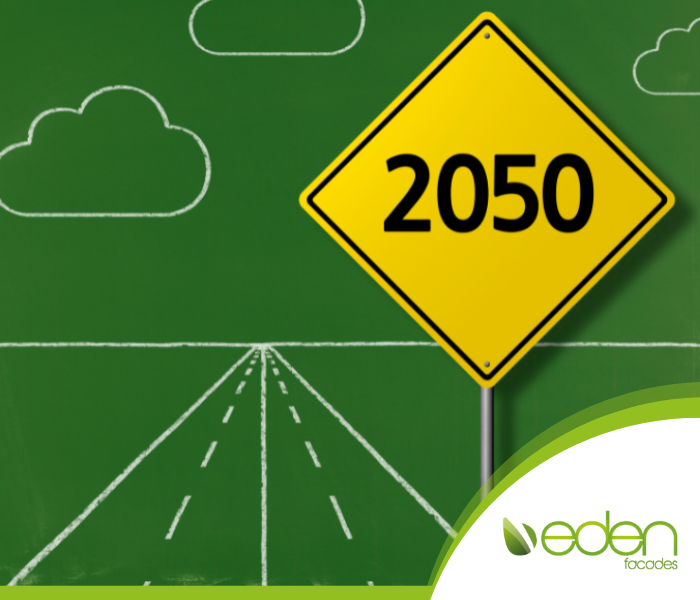“The built environment generates 42% of annual global CO2 emissions,” says nonprofit Architecture2030, so when governments and international organisations set climate goals, the construction industry’s response is vital.
By 2030, all new buildings must operate at net zero carbon, and by 2050, all buildings must operate at net zero carbon. Specifying rainscreen cladding for your projects is one of the most sustainable choices you can make to support these goals: as well as cutting energy bills substantially, it extends the life of your building, delaying future construction work and the associated emissions.
What is rainscreen cladding?
Rainscreen cladding is the attachment of an outer skin of rear-ventilated cladding to a new or existing building.
Rainscreen cladding is a construction method that involves attaching an outer layer of rear-ventilated cladding to a building. This outer layer protects the building from rain, while the inner layer provides thermal insulation, prevents air leakage, and can withstand wind loads. The outer layer functions like a breathable skin, while the inner layer reduces energy losses.
Why fit rainscreen cladding?
If the cladding is absent or fixed directly to the main wall, the summer sun hitting the building exterior conducts right in, making occupants turn on air conditioning. In winter, the heat from radiators conducts out. The air barrier helps prevent both effects, keeping temperature even and cutting energy use year-round.
Additionally, in hot weather, your air barrier tends to bleed off at the top and be replaced by welcome, cooler air. In winter, more air stays in place, helping the insulation contain interior heat.
Correctly fitted rainscreen cladding can cut energy use by 30 to 40%, rapidly recovering your investment and helping you achieve your sustainability goals.
Air isn’t the only thing that heats and expands, of course. Cracks and structural damage are often due to temperature changes in the inner structural wall. Avoiding this means your building will last longer and require less maintenance. The air also naturally helps dry moisture, avoiding structural problems due to condensation and humidity. The rainscreen cladding itself generally requires no maintenance.
Other wins include acoustic insulation alongside thermal insulation, and added value for your building.
Choose sustainable cladding materials
A range of materials are available to choose from, many of them highly sustainable. Here are some of the options.
Aluminium is a particularly popular choice for cladding and is considered one of the most sustainable construction materials overall. This durable but lightweight metal adds little load to the building structure, as well as being easy to transport and quick to install. Most importantly, the material is quickly and infinitely recyclable without loss of quality.
Timber cladding is a particularly beautiful and natural choice. Certification schemes exist which confirm the timber in question is sourced from sustainable forestry practices. PEFC and FSC are the two highly regarded certification systems. Unmodified timber has limitations that can make people wary, but modern timber cladding can be treated for extra durability and fire resistance.
Fibre cement, unlike standard portland cement, relies on materials such as cellulose and recycled wood. Even compared to other cladding materials discussed, it is exceptionally long-lasting. Properly fitted fibre cement panels can last for up to 100 years, so they can pass down the generations without further construction activity. Architecture2030, the source we cited at the start, reminds us that actual construction, as well as building operations, very much matter to the built environment and its carbon footprint.
Make sure your cladding is correctly installed
Fitting rainscreen cladding is a skilled job. Poorly fitted systems will underperform in terms of all of the advantages discussed and may require remediation.
References are vital when assessing a possible sub-contractor. If the company is an experienced specialist who can point to repeated and successful installations similar to the one you propose, there will be no difficulty with your systems.
With many years of experience and many satisfied clients who choose to work with us time and time again, you can rely on us to install rainscreen cladding on your project, getting it right the first time, every time.
Staying on track
The UK’s net zero goals are essential national priorities and an important part of global goals. Responsible, sustainable construction is central to whether we meet those goals. Rainscreen cladding systems will help you cut energy use and increase the life of your assets, ensuring we stay on the right side of our climate obligations.
Tony Hill, our Managing Director, says:
“Sustainability in construction is central to our mission here are Eden Facades. We would urge anyone contemplating rainscreen cladding to prioritise that area also, because enormous benefits are put naturally within reach when such a system is installed. Select your sub-contractor and cladding material carefully, and you can make your building more efficient and durable and contribute to wider, shared obligations.”
To speak to a trusted expert in rainscreen cladding installation, please get in touch using 01268 744199 or office@edenfacades.co.uk.

